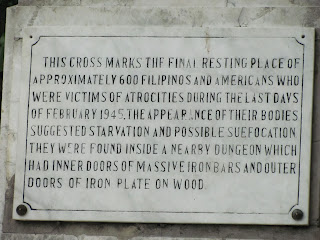Face to Face With History!
Little did we realize how dynamic a tour of Manila would be and how history would again come alive in our new living situation at the White House in Agpudlos, San Andres, Tablas Island, Philippines.
Manila takes no back seat to any other of the world’s leading cities for its banking district, its traffic or its unique character. Our first impressions came after midnight having unloaded into a terminal where all passengers had easy access to luggage carts (good news)! No one hassled us for money. We were met by Fred, the CESO rep who had a large card with our names under the ‘S’. The people lined up on either side of the very crowed road looked like they were at the race track all crowed against the fence. Fred text messaged the driver, Bong who took about an hour to make his way through this crowd to pick us up. The trip to the hotel took longer than the flight from Hong Kong! The traffic was unbelievable. We were fascinated by the gypsy buses. We later found out that the chassis are imported from Japan and each is uniquely built from all kinds of different aged parts. We laughed to think that we talk about our vehicles, identifying them by the year they were manufactured. Gypsy buses represent many years! They are privately owned and sure provide character to the city.
Our hotel, the Malvar, was a great spot for us. We were able to walk to a large mall that allowed us to shop, eat and enjoy the sights. We took a city tour that proved to be most interesting. The banking district of Manila:
They have done a great job of preserving history. Fort Santiago is where 600 Filipino died in 1945, victims of imprisonment by the Japanese. This same location was the site of the execution of Jose Rizal in 1896. His written works ‘fanned the flames of the Filipino revolution to gain freedom from Spain.
Our next stop was at the American Cemetery and Memorial to 6000 US soldiers who gave their lives to end the Japanese occupation of the Philippines. Below is one small part of the walkway where each name inscribed in marble. From the air, the burial ground is shaped like the American eagle.
Although we noted that a main battle occurred North of Talbus Island, little did we know how real this site would evidence itself in our living situation in San Andres.
Fast forwarding to our ‘place ‘ in San Andras , we are told that the place where we are staying, known as the White House was a ‘great’ house and that Japanese soldiers occupied the house for two weeks. Dario, the Ministry of Agriculture representative who is our guide, driver and mentor here, introduced us to his father who had to flee to the mountains during the invasion. His father says that they watched the airplanes bomb and sink the destroyer, witnessing the gun fire and the explosion (October 24, 1945). It was at the White House location where we are living that persons from the area were brought to be questioned. Dario’s relatives witnessed the beheading of a Filipino person here by the Japanese soldiers. No wonder they say there is a ghost in the house!











No comments:
Post a Comment